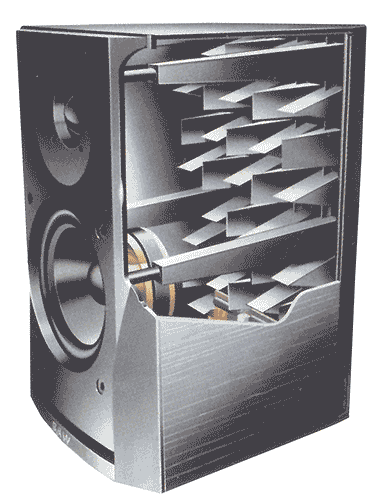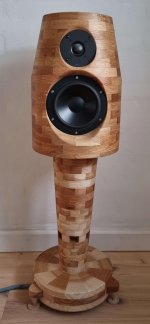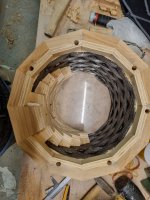I would like some technical comments on my design. That is, not whether it is beautiful or ugly.
Since the cabinet is cylindrical, the bass will penetrate much deeper into the cabinet than the tweeter.
I have tried to take this into account by making a slope at the top of the cabinet (12 degrees).
The Tweeter thus comes further back, so that bass and tweeter are now almost in line as if they were placed in a flat baffle.
They are therefore not in the acoustic center, so the slope should be greater or the tweeter should be recessed deeper
into the cabinet and there should then be a waveguide in the cabinet. But is it a problem that the treble plays up a bit
when the bass plays straight ahead. Wilson for example uses almost the opposite principle so that all drivers point directly to it
towards the listener.
Inside, there should be very little opportunity for standing waves. There are 12 edges that are offset from each other
and the front goes very deep into the cabinet, and is very uneven, so there are no large flat surfaces facing each other.
The bass reflex comes out through the base, so the base is part of the speaker.
Since the cabinet is cylindrical, the bass will penetrate much deeper into the cabinet than the tweeter.
I have tried to take this into account by making a slope at the top of the cabinet (12 degrees).
The Tweeter thus comes further back, so that bass and tweeter are now almost in line as if they were placed in a flat baffle.
They are therefore not in the acoustic center, so the slope should be greater or the tweeter should be recessed deeper
into the cabinet and there should then be a waveguide in the cabinet. But is it a problem that the treble plays up a bit
when the bass plays straight ahead. Wilson for example uses almost the opposite principle so that all drivers point directly to it
towards the listener.
Inside, there should be very little opportunity for standing waves. There are 12 edges that are offset from each other
and the front goes very deep into the cabinet, and is very uneven, so there are no large flat surfaces facing each other.
The bass reflex comes out through the base, so the base is part of the speaker.
Attachments
Yours may even be better that way.is it a problem that the treble plays up a bit
when the bass plays straight ahead. Wilson for example uses almost the opposite
An interesing butcher block build.
What does the inside look like?
Getting the VCs physically lined up does not get the drivers lined up. Where a driver’s acoustic centre is freuency dependent and moves.
It needs to be measured, or if you can get centre-to-cente within a quarer wavelength you will be very close.
dave
What does the inside look like?
Getting the VCs physically lined up does not get the drivers lined up. Where a driver’s acoustic centre is freuency dependent and moves.
It needs to be measured, or if you can get centre-to-cente within a quarer wavelength you will be very close.
dave
Last edited:
The inside is 12-sided. There is bracing between tweeter and bass. The front is made of very very thick material, as the bass in particular is lowered deep into the cabinet. But this means that there is nothing parallel between the front and the back, and I also think that it will break between the 2 sides. However, it is a bit difficult to talk about the sides and baffle, since it is all around one way (outsite). Since the top is conical, I also think that it must eliminate standing waves on the inside. There are no large parallel faces to each other, nor a single distance like a sphere. The distance between the drivers is 26 mm, and the bass is 180 mm and the treble 104 mm. Distance between centers is therefore 168 mm. XO is approx. 2000 Hz so the distance actually corresponds to 1/1 wavelength. Even if the drivers were right next to each other, it was not possible to have 1/4 wavelength between centers or ½ for that matter. I know that's what they say, but the units have to be incredibly small before it can be done. Are there any structures there 1/4 wavelength between centers.
The variations in distance across the enclosure do not look that significantly in relation to the total dimension. As a cylinder (approx) it will have a strong mode across the enclosure.
dave
dave
Thanks for the response. As for the fact that there is not such a big difference in diameter, I find it difficult to see that it would be worse than a square box where there are large faces facing each other. But I could be wrong. The baffle perhaps goes about 20% into the cabinet, so the distance between front and back is significantly smaller than from side to side. I'm thinking of making some spikes just like you see in soundproof rooms, but then I have to make the cabinet like a floor-speaker, otherwise I'll find it difficult to have enough volume. It is approx. 13 l. The cabinet thickness is generally between 30 and 35 mm, so the cabinet feels very very dead. You have to turn it up quite high before you can feel vibrations in the cabinet. But thanks for the input about being aware that a cylinder can be more vulnerable to standing waves.
But I could be wrong
In a cyclinder every horizontal dimension (upright cylinder) is the same. In every direction (ie an infinite number of parallel surfaces [at the limit]). In a box you only have 2 parallel sides and and direction that has any angle other than right angle is a different dimension.
A cyclinder is worse for (internal) resonace than a box. A sphere is even worse.
But the shape of your enclosure should have better extrenal diffraction and stiffer walls so that is good.
dave
As I said, it wasn't for the look I wrote about either. I'm happy with your response though, I'm aware that the look itself will divide the waters. I have had someone else who also thought they were ugly when I showed them on a Danish Facebook page. It's very unconventional, I'm aware. It actually took a while before I got used to them myself. My old design was also unconventional but much more ordinary to look at.
Similar idea in the MayFly MF-201. At large enough wavelengths most stuff like this loses efficacy. That doesn't mean it can't serve a purpose though.I'm thinking of making some spikes just like you see in soundproof rooms
https://www.stereophile.com/content/mayfly-mf-201-loudspeaker
Last edited:
If you could tolerate a FR driver on top, you could certainly drop that XO so as to reach sub-wavelength distance. Alpair 5 maybe? you'd have to make a separate chamber for it... Would it be possible to gain volume down a hollow stand leg?XO is approx. 2000 Hz so the distance actually corresponds to 1/1 wavelength. Even if the drivers were right next to each other, it was not possible to have 1/4 wavelength between centers or ½ for that matter.
I think the BB wood effect is striking. The black drivers w/o grilles against it, not so much. I wonder what would be an artistic way to cover them, while matching / complimenting the BB wood pattern and colors?
MayFly MF-201
I have seen that before. It is good in the respect we are talking… translam thou. Canadian.
These are another approach, B&W DM302.

dave
I have also considered having an even more chaotic structure on the inside to break standing waves. I have also seen another DIY that has some soft curves. My old cabinet (anno 1998) with the same kit also had quite a few arches inside. And when you build up from layers it is somewhat easier to deal with, both the MayFly 201 and my cabinet are built up from layers.
It is quite possible to get more volume, you can just extend the cabinet so that it becomes a floor speaker and drop the stand.
Tanks for respons
It is quite possible to get more volume, you can just extend the cabinet so that it becomes a floor speaker and drop the stand.
Tanks for respons
- Home
- Loudspeakers
- Multi-Way
- Design Comments

